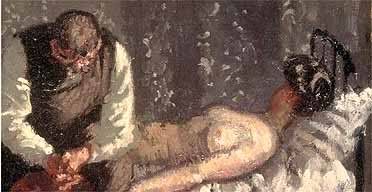Cows sawn in half, thousands of mutilated figures in scenes of the apocalypse, child killers portrayed using the painted hands of toddlers – modern artists go to quite some lengths in order to shock their audience.
Despite exposure to such things, it seems that the 100 year old paintings of Walter Sickert still have the ability to turn the stomach of today’s art fan.
Walter Sickert: The Camden Town Nudes runs until January 20, 2008 at The Courtauld Institute.
The exhibition displays works by the English artist from around 1902 to 1912.
Sickert’s reinvention of how nudes were portrayed in British art is a central theme although the big draw of this collection is likely to be the four Camden Town Murder paintings, which are displayed together for the first time.
Sickert, who once said, “all the greater draughtsmen tell a story”, used the murder in 1907 of a Camden prostitute called Emily Dimmock, to add a greater narrative dimension to his paintings.
The murder really captured the public’s fascination at the time and Sickert named a series of paintings featuring a nude and a clothed male, after ‘The Camden Murder’.
Ambiguity is a key factor though in Sickert’s paintings and alternative titles to these works exist, such as “Summer afternoon” and “What should we do about the rent?”
The truth about what is going on in these scenes is left up to the viewer.

Is the clothed man wringing his hands over money worries or has he just murdered the naked, lifeless figure on the bed next to him?
Unlike the elegant, grace of Degas’ ballerinas in one of the rooms next door, the form of the nudes in this exhibition is without poise.
The prostitutes who model for Sickert are mostly shown slumped, seemingly through exhaustion and as if their last reserve of energy was used to toss aside their clothes before crumpling onto the bed in ungainly poses.
This was Sickert’s response to the idealised nudes coming out of the Royal Academy which represented “an artistic and intellectual bankruptcy”, according to him.
The exhibition also gives audiences a chance to see how Sickert’s paintings developed.
Pencil drawn sketches are displayed alongside the finished works which allow us to see how the artist played around with composition before the final execution of his paintings.
While this exhibition doesn’t shock in a graphic, visceral sense, which is often the standard for contemporary artists, imaginative audiences with a sense of the story behind these paintings could be left unsettled.
Indeed when I arrived, a group of silver-haired ladies said, “I think we should move on. Jane finds these ones a bit difficult.”



1 comment:
ooh what a good blog Jim! Although if you continue to be a better art-writer than me I will arrange for you to meet with a nasty accident...you have been warned son.
FYI: The author Patricia Cornwell (america's #1 crime writer, apparently. Personally I think the Murder She Wrote lady is better) spent years and lots of money on trying, and failing, to prove that Sickert was Jack the Ripper
Post a Comment